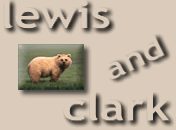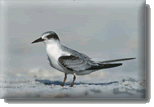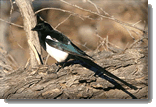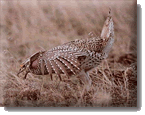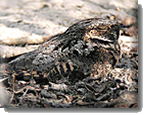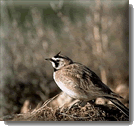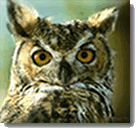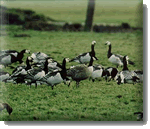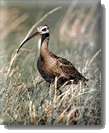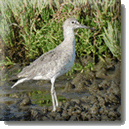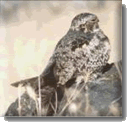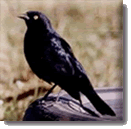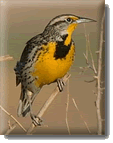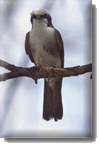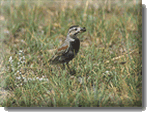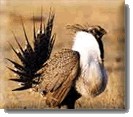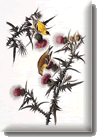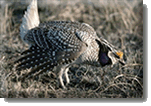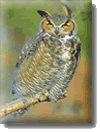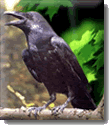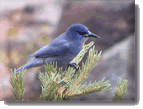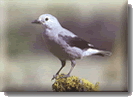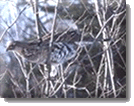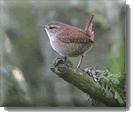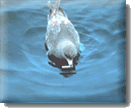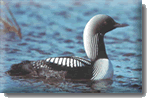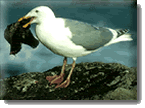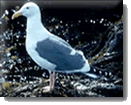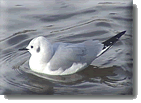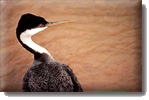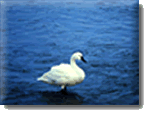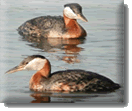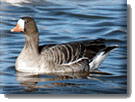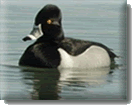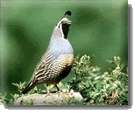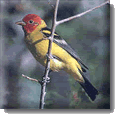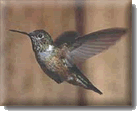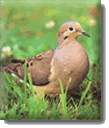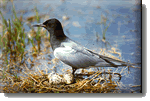| The Least Tern was a common sight to Lewis and
Clark on their expedition, but has since become
endangered due to uncontrolled hunting and loss of
habitat. The smallest of terns, it
measures 9 inches long and weighs only an ounce. It has a
glossy black crown, white forehead and undersurface,
pale gray back and wings, and black-tipped yellow
bill. |
|
|
The
Black-billed Magpie is a large black and white bird with
a long tail and dark bill. They have a rapid, nasal mag?
mag? mag? or yak yak yak, voice, and have been trained
to imitate a human voice when kept in captivity. Magpies
live in open woodlands, savannas
or in brushy growth near
streams. |
| One look at the Prairie Sharp-Tailed Grouse
and it's easy to see how it got its name. Its narrow,
pointed tail is a distinguishing feature as it roams the
grasslands, scrub forests,
and arid sagebrush. The sharp-tailed
grouse grows to length of 15-20 inches and sports brownish,
speckled feathers. |
|
|
The Whippoorwill is a chunky, dark,
wide-mouthed, insect-eating bird with a short curved
bill. They are named for their distinct, repeated call:
"Whip-poor-WILL!, Whippoorwill!, Whippoorwill!" The Whippoorwill
stays close to the ground in river valleys or watered
meadows, and is rarely
seen. |
| Discovered by Lewis and Clark near Fort
Mandan, North Dakota, the Prairie Horned Lark is brown
in color with a black stripe below and a white stripe
above its eye, a black crescent on its breast, and black "horns."
The horned lark is known for the way it travels; it walks
instead of hopping, and will sing its "tsee-ee" from any
slight elevation on the ground. It can be found in large
fields, open areas, shoreline beaches, grasslands, and
agricultural areas. |
|
|
The Great Horned Owl is hard to mistake
because of its large ear tufts
or "horns." It is a very large bird, measuring 18-25 inches
long with a wingspan of 48-60 inches. The color of these owls
ranges from very dark to almost as pale as the Snowy
owl. The Great Horned Owl has a loud, booming "Whoo,
whoo whoo, whooo, wooo-whooo...," voice. It preys on
medium-sized mammals and birds. It ranges from river
bottoms to forests throughout the United
States. |
| The Northern Flicker is a member of the
woodpecker family but you won't find them making a lot
of noise like his relatives. It spends a great deal of
time on the ground, searching for insects (especially ants),
fallen fruits, and seeds to eat. The flicker varies in color
depending on the region its found in: Eastern birds have
a black "mustache" and yellow on the wings; Western
birds have a red mustache and red on the wings; and
Southwestern birds have a red mustache and yellow on the
wings. They live in woodlands, deserts, and suburbs. |
|
|
Hutchin's Goose was sighted by Lewis and Clark
on May 5, 1805, above the mouth of the Poplar River in
Montana. It is looks like a small version of the
well-known Canada Goose. It is only about the size of a Mallard
duck. The Hutchin's Goose makes the same musical honking
noise and flies in the same V-shaped pattern, that the
Canada Goose does. It makes its home in lakes, bays,
rivers, and marshes. |
| The Long-Billed Curlew is the largest member
of the sandpiper family. Its total body length of 21-26
inches includes a bill that is up to 8 3/4 inches long.
This long, down-curved bill (which gave this bird the
nickname of "sicklebill"), and long legs are characteristic
of shorebirds (wading birds). Shorebirds are associated with
wetland or coastal areas.
The Long-Billed Curlew, originally discovered by Lewis
and Clark near Great Falls, Montana, was once a plentiful game
bird of the Great Plains. |
|
|
Western Willets are large, gray-brown
shorebirds, with a long straight bill. They have a
flashy black and white pattern on the underside of their
wings, which identifies them in flight. They have a loud ringing
"pill-will-willet" voice. They are found on coastal
beaches, freshwater and salt marshes, lakeshores, and
wet prairies. Lewis and Clark discovered them in May,
1805, at Fort Peck Dam,
Montana. |
| The Pacific Nighthawk is not a hawk, although
it acts like a hawk and catches flying insects on the
wing. It is also not a strictly nocturnal bird; it may also appear
during the day. It is mottled
brownish-black in color, and has a long notched- or square-tipped
tail and long pointed wings. The Pacific Nighthawk's has
a loud nasal call, "peent" or "pee-yah", that is heard
primarily at dusk. It likes to live in open woodlands,
clearings, or fields, or in towns with roosting trees or
fence posts. |
|
|
Brewer's
Blackbird, named for the 19th-century ornithologist, Thomas M. Brewer of
Boston, is a Robin-sized bird that makes its home in
prairies, fields, and farmyards. The male blackbird is black with
a purplish blue head and yellow eyes. Female blackbirds are
gray with dark eyes. They call with a gurgle, squawk,
and whistle. Brewer's Blackbird is a very social bird
and mixes with other species such as the red-winged
blackbird and the brown-headed cowbird.
|
| The
Western Meadowlark is the state bird of Kansas, Montana,
Nebraska, North Dakota, Oregon, and Wyoming! It is a
brightly-colored bird, about 8 1/2- to 11 inches long
and weighing about 3 ounces. The Western Meadowlark is
found in the fields, pastures, open grasslands, and
prairies of the western and central U.S. It feeds on insects, worms,
snails, spiders, grain and seeds. |
|
|
The White-Rumped (Loggerhead) Shrike is
slightly smaller than a robin, has a dark gray back,
white breast, and black bill, tail, and wings. It has a
black mask that extends across the eyes. It is known as the
"loggerhead" shrike because its head is large in proportion
to its body. The White-Rumped Shrike is also known as the
"butcher bird" because it impales its prey - usually a small
bird, mouse, or insect - onto a thorn or barbed wire
fence. This practice allows them to eat larger prey that they
cannot hold with their feet. |
| Lewis and Clark first noted the McCown's
Longspur in June 1805, near the Marias River in Montana.
This bird is about the size of a sparrow. It has a dry,
rattling call, but also will give a clear, sweet warble
during a fluttering flight with wings raised high over its back.
McCown's Longspur makes its home in the arid
plains, not liking moisture at all. It will abandon the
areas in which it is normally found if the weather gets
too wet. |
|
|
Sage Grouse, or sage cock, or sage hen, or
sage chicken, is the largest member of the family of
hen-like terrestrial birds
known as grouse. The Sage Grouse is about 25 to 30 inches long,
has short rounded wings, a blackish colored belly, and long
pointed tail feathers. Male grouse have a large white
collar-like patch that conceals air sacs. These air sacs
inflate during the male's elaborate courtship of the
female. The sagebrush plant is essential to the life of
the sage grouse. They the soft plant, nest underneath it, and use
it as cover from predators and weather.
|
| The American or Pale Goldfinch was spotted
by Lewis and Clark near the Marias River, Montana in
June 1805. Male birds are bright yellow with a white
rump, black forehead, white edges on black wings and tail
and yellow at the bend of the wing. Females are duller and grayer
in color. Their voice is a bright "per-chick-o-ree"
(sounds like "potato-chips") usually heard in flight.
Pale Goldfinches live in brushy thickets, weedy
grasslands, and nearby trees. |
|
|
The Columbian Sharp-tailed Grouse was an
important source of food for many Native Americans and
early settlers of the West. Columbian sharp-tails are
grayish-brown in color with black and buff markings, and white
spots on the wing feathers. They feed on forbs (clover, goldenrod, dandelion,
grass, grains) during the spring and summer, and fruit,
seeds and buds of native shrubs during the fall and
winter. They can be found in grassland, scrub forest, and arid
sagebrush areas. |
| First spotted by Lewis and Clark on the
Kooskooskee (Clearwater) River March 3, 1806, the Dusky
Horned Owl is a subspecies
of the Great Horned Owl (see description above). This owl is the
darkest colored of all the horned owls. Its home is the
forests, deserts, open country, swamps, and city parks
in areas of North America south of the tree line. The
Dusky Horned Owl feeds on grouse, ducks, and rabbits as
well as beetles, lizards, frogs, and skunks. |
|
|
How do you tell the difference between an
American crow and an American Raven? The raven is larger
and has a heavier bill and a wedge-shaped tail. The
raven's throat looks shaggy because of the long, lance-shaped
feathers that cover it. It often soars like a hawk through the
coniferous forests and
rocky coasts where it makes its home. The raven is a resident
of northern Alaska and northern Canada south throughout the
western United States and to Minnesota, the Great Lakes,
and northern New England; also the Appalachians to
northwestern Georgia. |
| Richardson's Blue Grouse is more of a
sooty-gray color than blue. Its neck is set off by
white-based feathers on each side. The Blue Grouse's voice
is a series of deep hoots, "whoop, whoop, whoop, whoop"
that increase in tempo and volume. It feeds only on conifer needles
during the winter, but eats a more varied diet during
the summer of insects, seeds, and berries. |
|
|
The Pinyon Jay is a stocky, short-tailed
jay bird, about nine inches long. They are gray-blue in
color with white streaks on the throat. Pinyon Jays
range from central Oregon and Montana southward to central Arizona,
New Mexico, and northwestern Oklahoma; they do not
migrate. Most of the Pinyon
Jays' diet is made up of pine seeds. They stay close to
forests with pinyon-juniper, ponderosa pine, douglas-fir,
redwood, lodgepole pine, fir-spruce, and aspen trees. Their voice
is a high-pitched "caaa." |
| Clark's Nutcracker was named after William
Clark who first saw the bird in the Rocky Mountains. It
is somewhat misnamed, however, because it uses its long,
stout beak to pry pine seeds from the cones of whitebark,
pinion, and other types of pines. It usually stores more than
enough for it to eat during the winter. These leftover
seeds then sprout new trees in the spring. The
combination of black, white and gray feathers make
Clark's Nutcracker a beautiful bird. |
|
|
The Oregon Ruffed Grouse was noted by the
Expedition on September 20, 1805, along the Lolo Trail
in Idaho. This grouse is a gray-brown, chickenlike bird
with a fan-shaped, black-banded tail. It can be found
from the tree line in Alaska and northern Canada, south to
California, Wyoming, Minnesota, Missouri and the
Carolinas, and in the Appalachians to
Georgia. |
| The Double-Crested Cormorants are 29 to 36
inches long and weigh up to 6 pounds. They have dark
brown to black colored feathers, a yellow-orange throat
patch, and a long hooked bill. Adult birds have tufts of feathers
above their eyes. Double-Crested Cormorants are known for
their feeding behavior in which they dive for fish,
crustaceans, and amphibians, from the water's surface.
Their oil glands are not well-developed so they aren't
waterproofed very well. They can often be seen perched
on a pole or tree with their wings spread apart to
dry. |
|
|
The
Western Common Crow is a stocky black bird with a stout
bill and fan-shaped tail. An intelligent, wary bird its
voice is the "caw-caw" or "caa-caa" we're all used to
hearing. Western crows lives in the deciduous growth along rivers and
streams, and in orchards and city parks. It was first noted by
Lewis and Clark in November 1805 at Tongue Point, near
present-day Astoria,
Oregon. |
| The Northwestern Crow was spotted by Lewis and
Clark at Fort Clatsop, Oregon, in March 1806. It is
smaller and more slender that than the American crow,
and is black with a purplish shine to its feathers. This
crow makes its home on the shorelines, tidewater areas, and along
the edges of coastal forest, from coastal southern Alaska
to Puget Sound in Washington. |
|
|
The Western Pileated Woodpecker, possibly the
largest woodpecker in the United States, is black with
white neck strips and a red crest. This woodpecker feeds
on insects (it especially likes ants), wild fruits, and
wild nuts. It pries off long slivers of wood to expose the ant
colonies underneath, and then uses its long, pointed tongue to
catch and eat them. Pileated Woodpeckers make their
nests in trees and poles. Their nests are about 8 inches
wide and 2 feet deep, and have been known to cause trees
and poles to snap. This can be a problem if it happens
to be an electric pole carrying someone's electricity!
|
| Winter wrens are somewhat misnamed because
they are some of the first birds back from migration in
the spring. Western Winter Wrens are more warmly colored
than their eastern counterparts. They have a short, stubby
tail, which they hold straight up in the air as they bounce around
beneath the tangles and thickets of forests. They were
discovered by the Expedition at Fort Clatsop, Oregon, in
March 1806. |
|
|
The Pacific (Northern) Fulmar is a stocky,
gull-like seabird. They come in two colors: pale gray on
the back and wings, with white elsewhere, and dark gray.
In flight, they take several fast wing beats and then go
into a stiffed-winged glide. They can be found in the open ocean
from the Pacific Ocean south to California, and in the
Atlantic south to North Carolina. Pacific Fulmars nest
on cliffs and rocky islands, often in colonies of
thousands of birds. |
| The Pacific Loon is a small loon with a
straight, slender bill. It was once considered to be a
form of the Arctic Loon, but recently was made a
separate species. Pacific Loons feed on small fish and other
aquatic life. They fish below the water's surface assisted by
well-developed air sacs, which allow them to stay
underwater for extended periods. Female loons will lay
two eggs, one a few weeks before the second. The first
egg is also the first to hatch and it becomes the dominant offspring. It is always
fed first, and in times when there is little food, is
the only one fed. |
|
|
Lewis and Clark made note of the
Glaucous-Winged Gull on March 7, 1806, at Fort Clatsop,
Oregon. It is a large white gull with pearly gray wings.
The Glaucous-Winged Gull makes its home near rocky or sandy
beaches, harbors, dumps, or the open ocean. You rarely find it
away from salt
water. |
| Often seen following fishing boats, the
Western Gull commonly feeds on scraps thrown overboard
by fish cleaners as well as small fish and marine
invertebrates. It can be found along
the west coast of North America and is hardly ever seen
inland or beyond the reach of the tides. To break open
the shells of their prey - like sea urchins and clams -
the gulls drop them from high in the air to hard
surfaces below. |
|
|
Bonaparte's Gull is a small, delicate gull
that is silvery gray above and white on the underside.
Adults have black heads that turn white in the winter,
leaving one dark spot behind the eye. Their voice is a raspy, nasal
snarling one. This gull is named after a nephew of
Napoleon, Charles Lucien Bonaparte, who was a leading
ornithologist in the 1800s
in America and Europe. |
| The Western Grebe is the longest of the
grebes, measuring 22-29 inches. It has a long slender
neck and long, slender, greenish yellow colored bill,
which it uses to spear fish to eat. Their voice is a rolling
"kr-r-rick, kr-r-rick!" Their feet are located far back
on their body, so they have a difficult time walking on dry land.
|
|
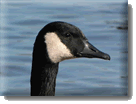 |
The Lesser Canada Goose is just what its name
says - a small version of the Canadian Goose. They are
migratory birds, spending spring and summer in Alaska
and northern Canada, and winters as far south as
northern Mexico. They fly in the familiar "V" formation
that allows them to cover 70% more distance than if they were flying
alone. |
| The Whistling (Tundra) Swan is a large, white,
very graceful bird. It is white with black legs, feet,
and beak. The "whistling" part of its name comes from
the sound made by the slow, powerful beating of its
wings in flight, and not to its voice. It is one of two swans
that are native to North America. They feed mainly on the
tubers and roots of aquatic plants that grow at shallow
depths in fresh, brackish, or salt
water. |
|
|
The Red-Necked Grebe is the second largest
grebe in North America. It is short-bodied, long-necked,
and long billed. Its diet consists mostly of minnows and
small fish, but it will also feed on crayfish, aquatic
insects, tadpole, salamanders, and vegetative matter. The Red-Necked
Grebe likes to nest in marsh grasses, reeds, rushes, and
calm rivers. |
| The Greater White-Fronted Goose was discovered
by Lewis and Clark in March 1806, at Fort Clatsop,
Oregon. It is a dusky brown goose with a white belly and
white patch on front of its face. Its voice is a bark of
"kla-ha!" or "kla-hah-luk!" These geese often migrate in
large flocks at night, when they can be identified by their
distinctive call. |
|
|
The
Ring-necked Duck gets its name from the brown ring around
its neck, which is difficult to see from a distance.
This duck is also called "ringbill" because of the white
ring at the end of its bill. Ringnecks like small bodies
of water and eat only plants, particularly wild rice,
and insects. They get about 16 inches long and weigh 1
3/4 pounds. |
| Hairy Woodpeckers are black and white
woodpeckers with long, chisel-tipped bills; males have a
red head patch. They are from 9 to 13 inches long. The
Hairy Woodpecker is a beneficial bird, feeding on many harmful
insects, such as wood-boring beetles. It finds its food by
feeling the vibrations made by insects moving about in
wood. They also can hear insects munch on wood. Like
other woodpeckers, it hammers on a dead limb to attract
females and to establish its territory. |
|
|
The Mountain Quail is the largest member of
the quail family. It differs from other western quail
because of its straight, narrow, black plume, consisting
of two feathers. Mountain Quail eat buds, acorns, flowers,
fruits, and seeds of shrubs and trees. They prefer dry mountainous
areas, brushy woodlands, and chaparrals. This quail migrates on
foot from higher elevations to protected valleys where
it winters in coveys of 6 to 12 birds. Members of the covey
seek warmth and protection by huddling in a circle, with their
heads turned
outward. |
| The
Western Tanager, northernmost of the 242 species of
tanagers, is commonly found in open coniferous forests.
It is found in the western United States and Canada; it
winters in Mexico and South America. The Western Tanager
eats a diet of fruits and insects. It looks for food in the
canopy of trees. |
|
|
The Broad-tailed Hummingbird greenish in color
and about 4 - 4 1/2 inches long. The male Broad-tailed's
wings make a cricket-like whistle in flight. It makes
its home in mountain meadows, pinion-juniper woodlands,
dry ponderosa pines, fir or mixed forests and in canyon vegetation.
This hummingbird nests in the same tree or bush year
after year. This is known as philopatry -
faithfulness to the previous home area. It will return
to the same branch or even build a new nest atop an old
one. |
| The Western Mourning Dove gets its name
from its low, mournful voice "coo-ah, coo, coo, coo." It
was discovered by the Expedition in July 1806, where
Lolo Creek empties into the Bitterroot River, Missoula County,
Montana. This dove is a soft, sandy buff color with a long
pointed tail, and black spots on the wings. It is found
in open fields, parks, and lawns with many trees and
shrubs. |
|
|
Forester's Tern is white with pale gray
back and wings, a black cap, and a deeply forked tail.
It has an orange bill with a black tip. It prefers to
live in inland marshes. |
| Franklin's Spruce Grouse is a dark,
chickenlike bird with a fan-shaped tail. The voice of
the male birds is a low "krrrk, krrrk, krrk, krrk,
krrk," thought to be the lowest-pitched vocal sound of any North
American bird. This grouse is sometimes called "Fool Hen"
because it can occasionally be approached and caught. It is
found in the Northern Rockies and
Cascades. |
|
|
